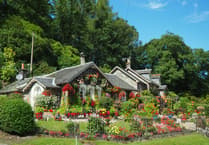Five Arches is the name that was given to the local history journal of the Radstock, Midsomer Norton & District Museum Society back in 1986, when its first issue was published.
The Five Arches’ milestone 100th edition is, as usual, packed with articles on local history accompanied by beautiful old photos. In fact, every one of the 100 issues is full of carefully researched, interesting, informative contributions covering a multitude of topics from across the former Somerset Coalfield: coal mining, local railways, stories from the world wars, school days of past times, local sports teams of bygone days, farming, and local businesses of the past and much more besides.
The name, Five Arches, relates to the viaduct of the five black, brick railway archways, some of which remain standing today, that carried the Somerset and Dorset (S&D) Railway over the Great Western Railway (GWR). Coming from Radstock and heading west, the S&D railway ran parallel with the GWR climbing in height before heading south over the GWR at Five Arches towards Midsomer Norton South Station; meanwhile, the GWR line headed away from Radstock towards Bristol via Farrington Gurney. Today, the GWR line is the Greenway cycle path. The former S&D line is now the cyclepath that runs behind Wheelers Road, Five Arches Close, the Midsomer Norton Town park, and the batch, coming out on Silver Street opposite Midsomer Norton South Station.
Five Arches shares the reminiscences of many local people, some of whom are sadly no longer with us; their memories of our towns and villages, and of growing up and working in our local communities, have been captured as a time capsule within the pages of the journal. The publication is also famous for its regular ‘Rambles’ feature, taking readers on a local history walk around different parts of the coalfield, with old photos and stories to accompany them on their way and, over the decades, has produced occasional special issues on special subjects.
None of this wealth of local history, collected and beautifully presented, would be possible without the dedicated Five Arches team of volunteers, headed for the last 29 years by Julie Dexter.
Julie took over the editorship in 1992, when original Editor, Julian Rutter, stepped down. Julian had started the magazine in 1986 and, when he handed over to Julie, it was an established and popular biannual magazine, which Julie increased to triannual publication which it remains today.
Dennis Herbert, Chairman of the Radstock, Midsomer Norton & District Museum Society said, “Each edition has covered a wide variety of topics and promotes the aim of the Society, to advance the education of the public in the history of the local area.”
Radstock Museum Chairman, Simon Carter said, “Five Arches is an important voice for the Museum Society and supports both The Society and The Museum (which houses and manages the Society’s collection) providing valuable income and publicity for both.”
Julie Dexter, Editor of Five Arches added: “The production of each issue has been a real team effort… Five Arches would not be what it is without them, whether they’ve been involved through the contribution of a single corner-filler or illustration or given a long-standing commitment as a team member.”
Current production team members are: Elizabeth Maggs, Keith Trivett, Dennis Chedgy, Tom Randall, David and Isobel Cheetham and Gill Hogarth. But anyone can contribute an article; do you have memories to share or knowledge of a particular local industry or way of life from the Somerset Coalfield area? The team would love to hear from you if you do.
Dennis Chedgy, the longest standing, team member has been with Five Arches from the beginning. Over the years, he has made regular contributions, many of which have taken the form of rambles. In the 100th issue he takes his daughter for an historical walk around his hometown, Radstock. Dennis begins his ramble with an introduction from a document held in the Museum archives from 1790 which states: “Radstock is a village situated eight miles south of Bath on the turnpike road from Bath to the city of Wells. It has an intersection here on the western side to part of the very old Roman Fosseway, part of which still exists, built with local stone, a raised convexed surface, some six feet in width and roughly a ¼ mile in length is visible. A new coalmine has recently opened here in the parish and is carried out with great success.”
Issue 100 of Five Arches and many copies of back-issues are available at Somerset Coalfield Life at Radstock Museum Shop.
You can also subscribe to Five Arches for £15 per annum (UK) including post and packing, via the museum website: radstockmuseum.co.uk or by sending your name and address and a cheque payable to ‘Radstock Museum’ to Dennis Chedgy, La Ronda, Manor Road, Writhlington, Radstock BA3 3NA.




